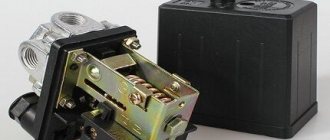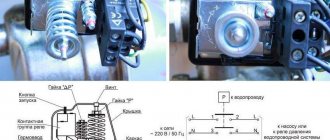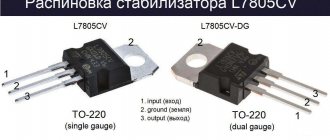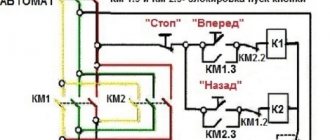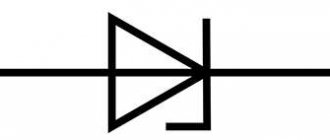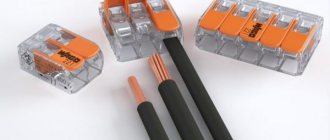Emission spectrum [edit | edit code]
Mercury vapor emits the following spectral lines used in gas-discharge lamps [1] [2] [3]:
| Wavelength, nm | Name | Color |
| 184.9499 | Hard ultraviolet (type C) | |
| 253.6517 | Hard ultraviolet (type C) | |
| 365.0153 | line "I" | Soft UV (Type A) |
| 404.6563 | line "H" | Violet |
| 435.8328 | line "G" | Blue |
| 546.0735 | Green | |
| 578.2 | Yellow-orange |
The most intense lines are 184.9499, 253.6517, 435.8328 nm. The intensity of the remaining lines depends on the discharge mode (parameters).
Advantages and disadvantages
Mercury gas-discharge lamps are an electric light source, one of the types of gas-discharge models. Their work is based on the passage of an electrical discharge through a gaseous medium.
DRL and DRV lamps are gas discharge lamps
Important! To designate light sources of this type, the term “discharge lamp” or RL is used.
Mercury lamps are divided into:
- DRV (interpretation - arc mercury-tungsten);
- DRL (or arc mercury phosphor).
The advantages of direct switching lamps DRV include:
- Ease of connection, use and replacement: they can operate on 220 V AC power and do not require ballasts;
- When warmed up, the resistance increases and stabilizes the network voltage - even at low voltage the light will be stable;
- They can operate from different power sources;
Lamps provide high-quality light
- The light sources are both tungsten filament and fluorescent radiation, that is, cold and warm white colors are mixed. This allows you to get more even light;
- Low price.
The disadvantages are:
- Low luminous efficiency. For example, the efficiency of Philips lamps does not exceed 30 lm/W, although other types of light bulbs from the same company have an output of up to 50 lm/W;
- A small selection of models: in stores there are only 5 models of different power;
- Short service life - no more than 3-4000 hours, and more often less. Replacement is quite expensive, this increases the final cost of the lamps.
Application area
This light source was good in its time, but now there are more effective modern solutions. Technically, DVRs can also be used for street lighting, but they are used very rarely in this capacity. But they are still found in park areas, parking lots, and construction sites. This is due to the initial short service life. The rarity of these lamps in street lamps is also explained by the inconvenience of replacement at a height of six meters or more.
More often they can be found indoors. They mainly illuminate production areas of industrial facilities and warehouses.
Thanks to the emission spectrum, DRV-250 can be successfully used for supplementary lighting of plants in greenhouse conditions. This applies only to the DRV-250 model.
Considering the shortcomings of these illuminators and their imminent removal from production, this lighting technology is losing its relevance.
- Related Posts
- Decorative neon lamp 220 V: principle of operation, characteristics, how to connect
- Lamps with e27 base: the most powerful, advantages and disadvantages
- Types of lamps with gu10 base, popular models, technical characteristics
Technology development
Technology has also improved. Metal halide lamps are now available. They have added iodine and other metal compounds to improve visible emission and color.
A new variety was created - DRV. This is a hybrid of a classic incandescent lamp and DRL. They have a tungsten filament added to them. It plays the role of a limiting resistor and a radiation source at the same time. The resistor is usually carbon. Here it is made of refractory tungsten. This design solution made it possible to abandon the use of a throttle. This lamp is connected like a regular incandescent lamp - it does not require additional ballasts.
Technical characteristics of DRV and DRL lamps
There are models of various powers on the market: 160 W, 250, 500, and occasionally you can find 700 and 1000 W.
Light bulbs available in different wattages
Below is a technical description for DRV 250 lamps (they are used for artificial lighting in greenhouses):
- Lamp length is 22.5 cm, diameter - 9.1 cm;
- Service life - 3000 hours (on average);
- Luminous flux - 4700 lm;
- Light output level - 18.8 lm/W;
- The voltage is 220 W;
- Nominal power level - 250 W;
- An E40 type base is inserted.
Other models will have different characteristics.
Explanation of markings
In the name of the DRV lamp, the decoding of the symbols is as follows: “arc mercury-tungsten.” According to the principle of operation, it is similar to sodium and mercury light sources, but unlike them, it has a tungsten spiral, which allows you to turn on the device without an external ballast that regulates the starting voltage.
All fluorescent type spotlights operate on alternating current from a 220 V network. Chokeless devices with an e40 base have increased luminous efficiency compared to conventional incandescent lamps and have a long service life. When they fail, they require special conditions for disposal.
Decoding the alphabetic and digital markings allows you to select a device with optimal power in accordance with the user’s requirements. The lamps are recommended for use in lighting systems for public areas. Depending on the characteristics of the device, a direct stream of light will help illuminate a parking lot, park area, greenhouse, street, construction site, room for animals and poultry, and utility yard.
Economic advantages of mercury lamps
Cost-effectiveness of use is one of the reasons for the great commercial success of tungsten devices, not only in Russia and the CIS countries, but also in developed Western countries. The fact is that strong and powerful incandescent lamps left behind huge umbrella lamps , which, especially in large industries, are extremely expensive to replace in all respects. The costs will be as follows:
- purchasing new lighting fixtures;
- installation of fastening systems;
- installation of lighting lines.
All these expense items can be reduced by installing tungsten light sources in old lamps. These hybrid type light sources are more efficient. It is worth noting that in most cases, purchases of high-pressure mercury lamps are made specifically for DRV devices.
But there are a number of nuances. For example, their light parameters are significantly inferior to even the most inefficient DRL lamps. Why is this happening? Let's find out what the operating principle of DRV lamps is.
Features of the DRV 250 lamp
The mercury-type energy-saving lamp is produced by the largest world-famous companies specializing in the supply of lighting fixtures and equipment components. Products are manufactured from modern materials using innovative technologies.
The DRV 250 light bulb consists of a flask with a high-pressure argon medium, a tungsten spiral and a mercury discharge torch. It does not require a starting control device. The product can be installed in ordinary sockets, just like the usual incandescent light bulbs.
There is an opinion that in everyday life and at work it is better to use a hybrid light source with increased emission potential. In practice, it turns out that the performance characteristics of e40 are 50% lower compared to inductive choke DRL devices. The reduction in pulse efficiency occurs due to the limitation of the voltage flowing through the burner head. Its power and resistance are controlled by a starting device.
When the light bulb is activated, a cathode drop in the operating mode to 20 V occurs in the choke light source. After the main element of the e40 gas-discharge lamp lights up, its voltage rises, and the voltage readings on the tungsten coil decrease exponentially. The technical characteristics and design of the working elements, compared to an incandescent lamp, which can be distinguished by the design of the working elements and appearance, provide a brighter glow. The spiral has 30% less electrical energy.
Principle of operation
The operating principle of gas-discharge lamps is a little more complicated than that of incandescent light bulbs.
- When current is applied, voltage is transmitted to the current-carrying parts of the base;
- Then the energy passes through the circuit to the electrodes located in the burner, and a glow discharge appears between them. Ions and free electrons begin to accumulate on the surface;
- As ions and electrons accumulate, the internal space of the burner begins to heat up, and the mercury evaporates. The discharge occurs from a glowing state to an arc state, which creates blue or violet radiation;
- This glow causes the phosphor to glow, which creates a reddish light. When all colors are mixed, the result is white.
You can examine the inside of the lamp only by breaking the glass bulb.
The more mercury vapor evaporates, the more the brightness of the discharge increases. On average, it takes 4-5 minutes for the DRL to light up, while the DRL lights up almost immediately.
Important! The higher the air temperature, the less time it will take.
Design
The design of the DRV lamp is similar to the design of mercury burners. DRV and DRL lamps consist of the following parts:
- Base of standard design. It has 2 points for receiving electricity - in the center and on the side. The base itself is screwed into the cartridge and can be easily changed if it burns out;
- Quartz burner in the form of a tube. This is the main element of the lamps. There are 2 electrons on both sides - the main and the auxiliary; the flask itself is filled with argon and mercury vapor;
- Glass flask. It is “put on” from above and filled with nitrogen; the inside is painted with a white phosphor, which is why the light bulb is opaque.
The diagram makes it easy to understand the operating principle
Disposal of mercury lamps
Spent and defective mercury-type lamps belong to the first hazard class waste. They must be disposed of using special equipment. During the processing process, one of four methods can be used:
- amalgamation;
- heat treatment;
- firing at high temperature;
- chemical or metallurgical method.
All disposal methods are aimed at separating and sedimenting mercury vapor, its sublimation, followed by burning of organic components. The final products of processing DRV and DRL lamps without chokes are mercuric chloride and sorbent.
- Author: admin
Rate this article:
- 5
- 4
- 3
- 2
- 1
(0 votes, average: 0 out of 5) Share with your friends!
Types of lamps
The DRL marking means arc mercury phosphor, the marking DRV means arc mercury tungsten. At first glance, it is difficult to distinguish between DVR and DRL lamps. The differences lie in their technical characteristics. The design of both light sources includes:
- Base. An element that receives electrical energy from the network due to the connection of the contacts of the socket and the lamp.
- Quartz flask. Filled with argon with the addition of a drop of mercury, it has two main and two auxiliary electrodes. Acts as a burner
- Glass flask. Acts as a container in which the quartz flask and base are placed. The inner surface of the flask is coated with a phosphor and filled with nitrogen.
Inside a tungsten lamp, along with a quartz bulb, there is a tungsten spiral. This spiral serves as a current-limiting element.
The high demand for mercury arc lamps is explained by the cost-effectiveness of their use. They are now used in various lighting devices instead of outdated incandescent lamps. Thanks to this, it is possible to avoid high costs associated with:
- with the purchase of modern lighting fixtures;
- with installation of fastening systems;
- with wiring of lighting lines.
In addition, mercury devices show significantly higher operating efficiency than other light sources. However, when comparing the performance of a phosphor lamp and a tungsten lamp, some differences are observed.
Marking
In domestic practice, the number following the DRL means power consumption in W. Next comes the red ratio: the ratio of the red flux (from 600 to 780 nm) to the total - expressed as a percentage. The development number is separated by a hyphen. The red ratio characterizes color rendering; values above ten are considered good.
According to the international standard IEC 1231, the ILCOS system is used. These are competitors of the German LBS marking and the pan-European ZVEI. There is complete chaos in the market. According to ILCOS:
- QE stands for ellipsoidal bulb shape.
- QR denotes a bulb with an internal reflective layer, mushroom-shaped.
- QG stands for spherical flask.
- QB stands for products with built-in ballast.
- QBR stands for products with built-in ballast and reflective layer.
Philips has its own view of things, but General Electric doesn’t want to hear about either. Actually, it is better to rely on reference books or read the information on the packaging. Remember that the base comes in standard sizes and in other sizes. The share of DRL lamp production is continuously decreasing, so there is no point in studying complex designations in too much detail. And given the entry of LEDs into the market, it is better to find something modern and constantly evolving for your home and garden. As for efficiency, the dispute will clearly not be resolved in favor of discharge lamps, although for some time they successfully deposited the filament.
DRV and DLR lamp - which is better to choose
DLR stands for "Arc Mercury Fluorescent Lamp". The active luminous element in it is an electric arc that occurs between 2 electrodes and operates in mercury vapor.
The DRV lamp is a mercury tungsten lamp that operates without a choke. It looks like a combination of a DRL burner and a tungsten filament, the latter performing the function of an induction ballast.
On the right is a DRL lamp, on the left is a DRL lamp, the power of both is the same
Despite the similarity of DRL and DVR, there is still a difference between them:
- To ignite a DRL, a ballast is required; for a DRL it is not needed (this is a chokeless bulb);
- The luminous flux of the DRL is 40-50% lower than that of the DRL, but it turns on immediately and does not warm up for several minutes;
- The service life of DRL is longer than that of DVR, since the tungsten filament breaks down quite quickly;
- Many users also note that DRV light bulbs are more energy-consuming.
Types [edit | edit code ]
High pressure mercury lamps type DRL [edit | edit code]
DRL
(
Arc
Rmulium
Luminescent
domestic the radiation of a phosphor applied to the inner surface of the bulb is used to correct the color of the light flux, aimed at improving color rendering. To produce light, DRL uses the principle of constant burning of a discharge in an atmosphere saturated with mercury vapor. [4]
It is used for general lighting of workshops, streets, industrial enterprises and other facilities that do not have high requirements for the quality of color rendering and rooms without permanent occupancy.
Device [edit | edit code]
The first DRL lamps were made with two electrodes. To ignite such lamps, a source of high-voltage pulses was required. The device used was PURL-220 (Starting Device for Mercury Lamps for a voltage of 220 V). The electronics of those times did not allow the creation of sufficiently reliable ignition devices, and the PURL included a gas discharger, which had a service life shorter than that of the lamp itself. Therefore, in the 1970s. industry gradually stopped producing two-electrode lamps. They were replaced by four-electrode ones, which do not require external ignition devices.
To match the electrical parameters of the lamp and the power source, almost all types of RL that have a falling external current-voltage characteristic require the use of a ballast, which in most cases is a choke connected in series with the lamp.
A four-electrode DRL lamp (see figure on the right) consists of an external glass flask 1, equipped with a threaded base 2. A quartz burner (discharge tube, RT) 3, mounted on the geometric axis of the outer flask, filled with argon with the addition of mercury, is mounted on the lamp leg. Four-electrode lamps have main electrodes 4 and auxiliary (ignition) electrodes 5 located next to them. Each ignition electrode is connected to the main electrode located at the opposite end of the RT through a current-limiting resistance 6. Auxiliary electrodes facilitate ignition of the lamp and make its operation more stable during the start-up period. The conductors in the lamp are made of thick nickel wire.
Recently, a number of foreign companies have been producing three-electrode DRL lamps, equipped with only one ignition electrode. This design differs only in greater manufacturability in production, without having any other advantages over four-electrode ones.
Operating principle [edit | edit code ]
The burner (RT) of the lamp is made of a refractory and chemically resistant transparent material (quartz glass or special ceramics), and is filled with strictly dosed portions of inert gases. In addition, metallic mercury is introduced into the burner, which in a cold lamp has the form of a compact ball, or settles in the form of a coating on the walls of the flask and (or) electrodes. The luminous body of the RLVD is a column of arc electric discharge.
The process of igniting a lamp equipped with ignition electrodes is as follows. When supply voltage is applied to the lamp, a glow discharge occurs between the closely located main and ignition electrodes, which is facilitated by the small distance between them, which is significantly less than the distance between the main electrodes, therefore, the breakdown voltage of this gap is lower. The appearance in the RT cavity of a sufficiently large number of charge carriers (free electrons and positive ions) contributes to the breakdown of the gap between the main electrodes and the ignition of a glow discharge between them, which almost instantly turns into an arc.
Stabilization of the electrical and light parameters of the lamp occurs 10-15 minutes after switching on. During this time, the lamp current significantly exceeds the rated one and is limited only by the resistance of the ballast. The duration of the start-up mode strongly depends on the ambient temperature - the colder it is, the longer the lamp will light up.
Advantages and disadvantages of an electromagnetic choke
Now let's talk about the advantages and disadvantages. The advantages of an electromagnetic choke include:
- Relatively low cost.
- Simplicity of design.
- Durability.
Unfortunately, this device has a few more disadvantages. This:
- Large weight and dimensions.
- Flickering of a lamp with double the mains frequency.
- Buzzing.
- Low efficiency due to high inductive reactance.
- At negative voltages, the lamp may not start.
- Long startup (from 1 to 3 seconds).
- During a difficult start-up, the lamp may “blink” for a long time, causing its coils to burn out.
Scope of application
DRV light bulbs are used to illuminate large spaces: streets, open spaces (for example, parking lots), industrial facilities (open and closed).
DRLs are used for lighting:
- Streets and roads;
- Squares, courtyards, squares;
- Warehouses, workshops and other large industrial premises;
- Car parks and gas stations.
Lamps are regularly used to illuminate large spaces
DRV is used in the following places:
- Boulevards, squares, parks and other city blocks;
- At construction sites;
- Warehouses and industrial facilities;
- DRV 25 is used in greenhouses because it produces a redder color.
Safety regulations
When using a lamp, you must follow some safety rules:
- Before installing the light bulb, you need to carefully unpack it and make sure there are no mechanical damages;
- It is prohibited to screw in or operate a faulty lamp; you also cannot use an open lamp in an open place where it is not protected from wind or precipitation;
The light bulb must be intact
- After installation, it is necessary to carry out a test by turning on the lamp for 10-15 minutes. After that it can be used. It is important to remember that DRV lamps take several minutes to light up;
Important! If the network voltage is higher than 220 V, the lamps will fail faster and their service life will end earlier.
- Any installation of the lamp must be carried out only with the electricity turned off;
- If the light bulb becomes dirty, wipe it with a dry soft cloth. Solvents or aggressive cleaning agents must not be used;
- The lamp can be placed in any position - both horizontally and vertically;
- Light bulbs should be stored in packaging, not dropped or broken, they should not be given to children or allowed to play with;
- It is necessary to dispose of lamps by handing them over to a collection point for mercury lamps.
Due to mercury vapor, disposal must be carried out at special points
If the light bulb does break, you must:
- Ventilate the room for at least 30 minutes, after leaving it;
- Wear disposable gloves and sweep all large parts into a bag using paper or cardboard;
- Use a wet sponge or tape to collect small pieces. Mercury must be collected moving from the edges to the center;
- At the very end, clean using chlorine.
It is necessary to clean up the mercury spill site with chlorine
DRV and DRL light bulbs are often used to illuminate streets, warehouses, workshops and construction sites. They are easy to install and use, easy to install and change, and provide good quality light. However, both lamps are classified as hazard class 1 due to their mercury content and should be used with caution.
LED E-40 to replace DRL-250
Without advertising to certain brands, we can note the most reputable domestic and foreign companies that produce high-quality LED lamps in the E-40 base, which can replace the DRL-250:
E40 BRIGHTLUX IP65 60W – from 7000 rubles, E40 SAMSUNG 60W (Corn) – from 3000 rubles, E40 SDL-KS-60 60W 220V SMD Corn ( Euroled ) – from 4300 rubles, E40 Philips Corn – from 3500 rubles, E40 60w Corn ( Corn) Goled – from 3600 rubles,
conclusions
You can also remember that gas-discharge lamps such as DRL-250 and DRL-400 use mercury. They are harmful in themselves, and a large number of them in production is undesirable. Another weighty argument against mercury lamps is that they will cease to be produced approximately in 2022, then their LED analogues will occupy the lion’s share of the market. Those who say that the luminous flux of mercury lamps is higher than that of LED lamps forget that LED lamps have a higher color temperature. This fact visually neutralizes these differences. Thus, we can conclude that a lower luminous flux cannot be considered a serious disadvantage.
Technical aspects
The most important indicators of a mercury light source with an e40 base are the design of the internal part of the device, the shape of the bulb, and the dimensions of the threaded base. The economic effect of the device may differ in operating conditions. The gas-discharge soffit from the Lisma brand for street lighting, which does not create a flickering effect in the event of voltage surges in the electrical network, does not require a special device for igniting the arc. At a power of 500 W, a luminous flux of 4 - 5 thousand lm is created.
- Name - DRV lamp;
- Type - mercury;
- Power - 500 V;
- Shape - ellipse;
- Manufacturer - ;
- Purpose - street;
- The flask coating is matte;
- Base - e40.
When marking energy-saving appliances, digital and letter values are used to indicate the power and type of product. It is not difficult to decipher these meanings. Examples:
- DRL 250 - arc mercury phosphor lamp with a power of 250 V;
- DRV 160 is a mercury-tungsten arc lamp with a power of 160 V.
The source of an even luminous flux DRV 500, the characteristics of which are determined by the parameters of the base, can have a mixed type design. The starter circuit may contain a choke. The ballast serves to reduce the voltage on the electrodes by increasing the voltage in the active luminescent device. The device is made in the form of a coil with a wire wound around a ferromagnetic core. To reduce reactive energy in the E40 lamp circuit, it is enough to disconnect the compensating capacitor.
The technical characteristics of the device are adapted for open spaces. The DRV 500 lamp demonstrates excellent results at a voltage of 220 V with a current oscillation frequency of 50 Hz. The devices are designed for continuous operation for 7.5 thousand hours.
DRL lamps detailed description
In fact, DRL lamps are deciphered quite simply:
- D - means that the lighting fixtures are arc.
- R – mercury. Therefore, it is not recommended to use such lamps during home use. After all, if they accidentally break, the harm to the health of all people may be too great.
- L – luminescent.
As you may have noticed, decoding these lamps is quite simple. Now let’s remember the main modifications of DRL. Now the most popular lamps are the following ratings:
The modifications are designated as follows: “DRL” + “number”, which is indicated above. Please note that the number is the lamp power in Watts, so when choosing, pay attention to the second indicator, it is the main one.
And this is what the design of DRL lamps looks like.

